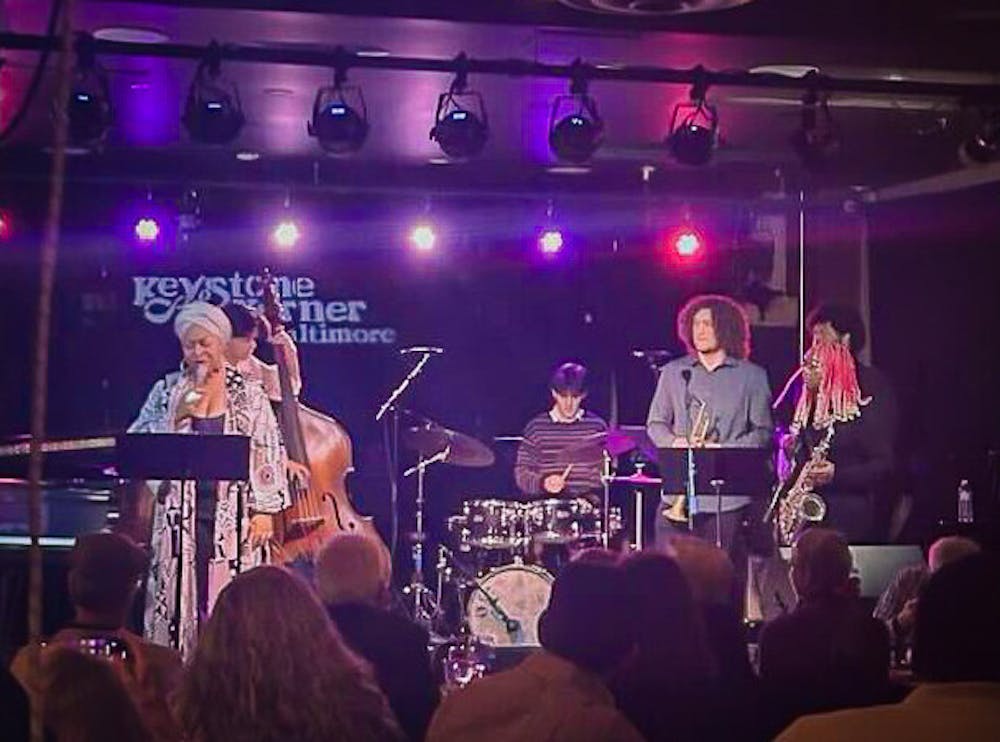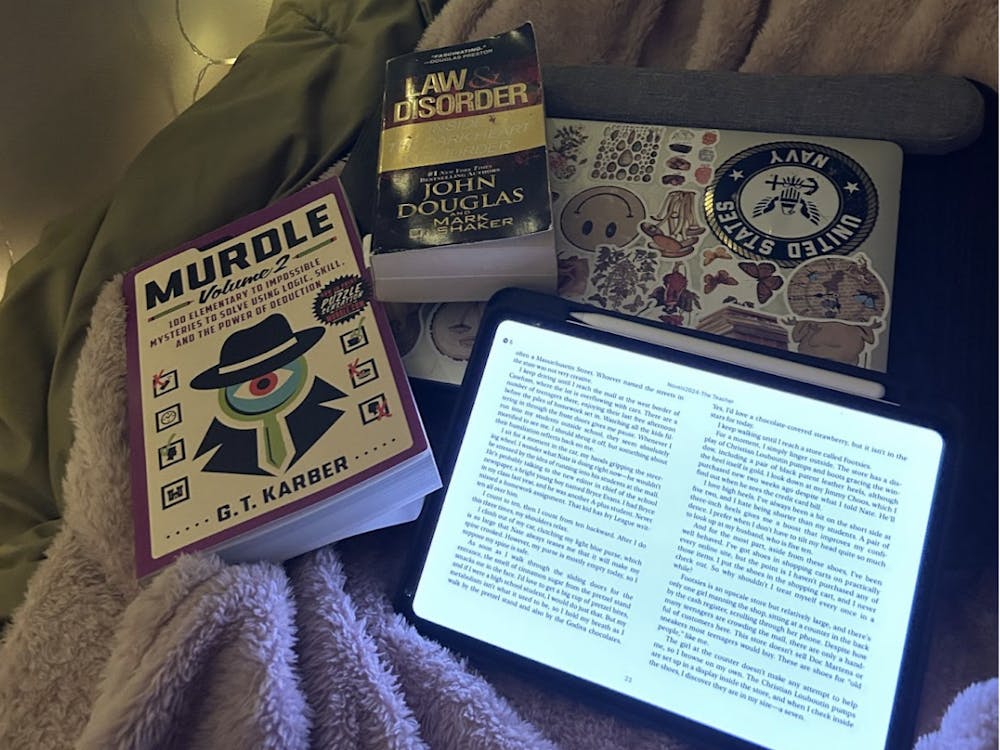Baltimore’s beloved jazz singer, the late Ethel Ennis, would have turned 91 years old last week. She is known for her smooth vocals, her expressiveness and her ardent authenticity; never a fan of record labels, Ennis walked away from the superstar track so that she could do things her own way. Billie Holiday once said to her, “You have a great voice. You don’t fake it.” Frank Sinatra said she was “my kind of singer.” Keystone Korner Baltimore celebrated Ennis’ birthday on Wednesday, Nov. 29 with a gigantic vanilla cake and a series of performances to match her silken songs.
The venue was already beginning to meld into Ennis’ world when I arrived. The low light of wall lamps warmed table conversations, bars and booths, and the sound of clinking silverware awaited the evening’s first note. A painted portrait of Ennis hung at the entryway where guests — parents, friends, musicians and lovers — were filing in. This was not a bar that Ennis would have performed at; nonetheless, her presence was felt in the rhythms of that space. When the first act, renowned vocalist Charenée Wade, sang the first lines from Ennis’ song “Hey You,” her specter was only solidified, “Hey you, are you doing what you want to do? / Yes you, are you doing what you want to do? / ‘Cause life’s a treasure, time’s a measure / So why not to yourself be true?”
The question continued through the song, at once demanding and freeing, with delicious instrumentals provided by the Peabody Jazz Ensemble. It’s a simple question, though difficult for many to answer, and Ennis’ messages of passion and authenticity rippled throughout the audience. There was even a moment in which Wade used call-and-response, asking the audience to echo the high melodies of the chorus, before trailing off in quiet unison. A perfect first song.
As the first song ended (met by much whooping and applause) and the next one began, it became clear that passion and authenticity were not values exclusive to Ennis. In an interview with The News-Letter, Peabody Institute Pianist Hannah Mayer talked about jazz improvisation.
“I wouldn’t say it’s difficult. It’s just, I don’t know, I guess having integrity and sticking true to what you’re hearing in the moment,” she explained.
The ensemble’s drummer, Claudio Silva, echoed this sentiment of steady passion and dedication. When asked if he was nervous to be performing, he smiled.
“No, because this is what I do, you know? And this is what I’m supposed to do,” he said.
When the next song began, I was sitting beside the sound technician, Warner Harper, who calls himself “Bala.” Bala had been tasked with the care of all the stage microphones, as well as the quality of the live stream that was being broadcast to audience members at home. So far, he’d been adjusting levers, drumming out rhythms and checking the sound through a pair of headphones. Now, though, he turned to me and said something about watching out for a new microphone. This microphone would be attached to someone’s shoe, from what I could understand — specifically to the shoe of performer Brinae Ali. “To her shoe?” I asked, but the song had begun and Bala’s attention was on the stage.
I soon understood why. Ali is a tap dancer, and her performance brought an entirely new dimension to the songs “(Brother Bill) Last Clean Shirt” and “Soft Power.” There was the auditory aspect, with percussion sounding from each heel-click and toe-tap on the wooden boards. It was a rhythm irreplicable by any instrument other than legs and shoes, and its cascading cadences blended seamlessly with the vocalist and ensemble.
“Soft Power” was especially surprising. It was a slow song, romantic and sweet — the last place I would have expected tap dance. Yet with soft power and incredible deft, Ali tapped out the quiet rhythms of the song.
Later, in an interview with The News-Letter, Assistant Curator Raynetta Wiggins-Jackson reflected on the surprise of the moment. “Wow!” she remembered thinking. “So this is what we’re doing. And it worked!”
She told me that this small surprise was only one example of the greater astonishment that jazz can create, with the help of talented performers — and there was no shortage of talent. Beyond the musical aspect, there was Ali herself: vibrant in a pearl-studded top and feathery coattails, spinning, gesturing and surprising.
As the evening continued, other performers took the stage. The Baltimore School for the Arts Jazz Ensemble rendered, among other songs, a hypnotic version of “Moon River” with vocals from within the ensemble. Murmurs from all around me came to one consensus: It was difficult to believe these were high school students. Acclaimed pianist Cyrus Chestnut played “Everything Must Change” with fanciful twists, before accompanying Wade in a performance of “But Beautiful.” Each of these classics melted into the space as they were played; they were floating to the ceiling, sticking to the walls.
Between these performances, two toasts were given by one man: Earl Arnett, Ennis’ husband. When Ennis married Arnett in 1967, she was breaking the state’s then-existing anti-miscegenation laws. They stayed together for the next 51 years. Arnett announced his memoir about their marriage, A Jazz Romance, and described Ennis and her impact on Baltimore in his first speech.
“I can kind of speak as a Baltimorean, and the strength of a city like Baltimore comes from the diversity that we see right here,” he said. “It comes from many different kinds of people who come together, recognizing their commonality. And music is such a beautiful way to bring people together. And that’s how Ethel always used her music.”
The final act of the evening was a bringing together of Wade, Ali, Chestnut and the Peabody Jazz Ensemble. It was a colorful spin on “Love For Sale,” with equal parts flourish and grace. A perfect last song. The evening ended, final speeches were given and hearts were unstuck from the ceilings and walls. I finished my slice of that gigantic vanilla birthday cake and got up to go.
In conjunction with this event, there is an exhibition at the George Peabody Library curated by Wiggins-Jackson called “Ethel's Place: Celebrating Ethel Ennis, Baltimore's First Lady of Jazz” available through March 2024. It is expertly crafted from a trove of sheet music, photographs, sketches and articles from the University’s Special Collections. This is the history that the concert drew on: Wade, for example, spent many hours looking at Ennis’ old sheet music in preparation for the performance. It is rich with information on both Baltimore and the legendary Ennis, and I encourage everyone to go see it.





